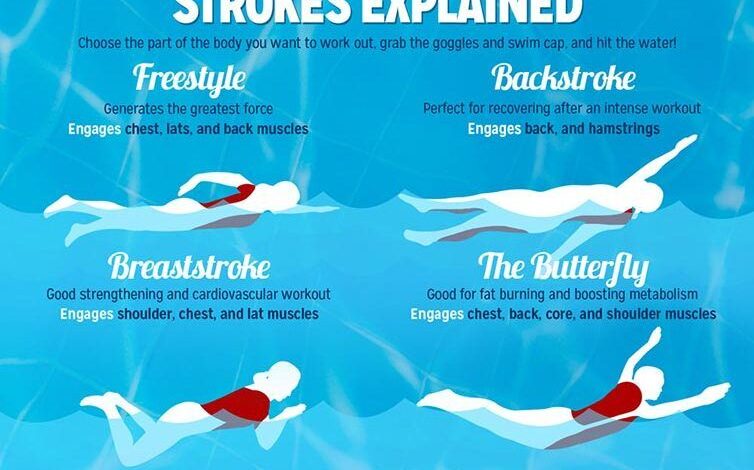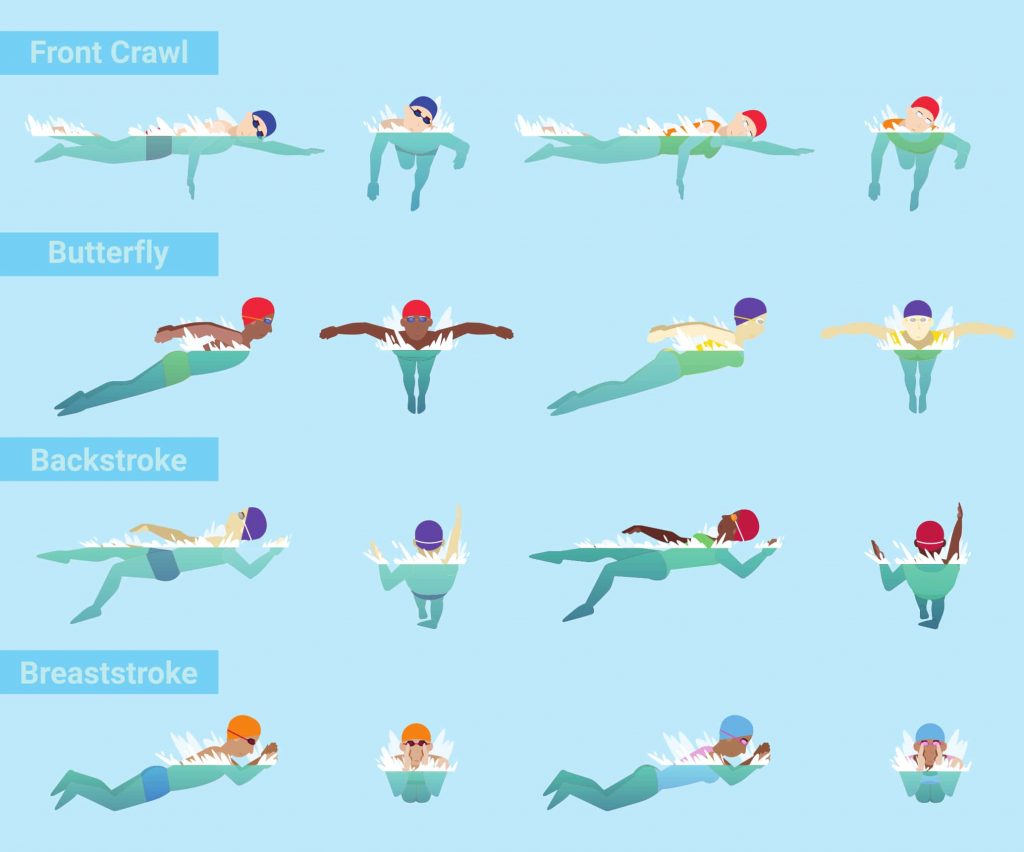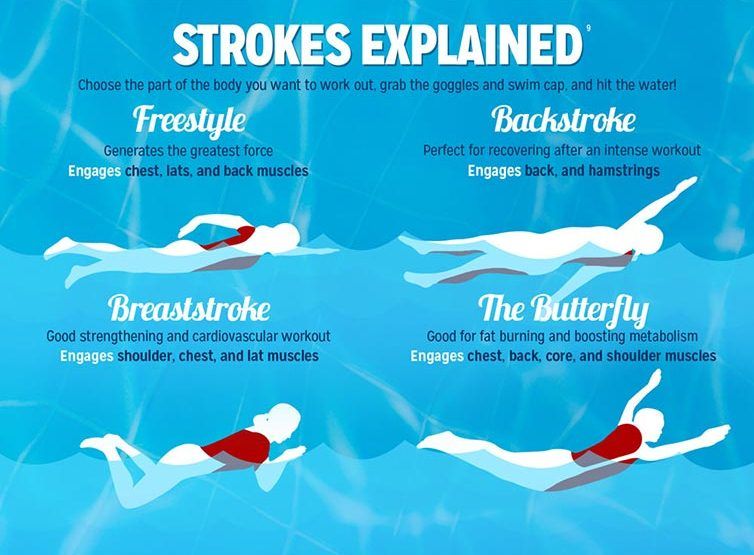
4 Basic Swimming Strokes to Know: Mastering the Water
4 Basic Swimming Strokes to Know: Mastering the Water is a journey into the world of aquatic movement. Whether you’re a beginner looking to dip your toes into the pool or a seasoned swimmer seeking to refine your technique, understanding these fundamental strokes is essential for a safe and enjoyable swimming experience.
These four strokes, freestyle (crawl), backstroke, breaststroke, and butterfly, form the foundation of swimming. Each stroke utilizes different body mechanics and breathing patterns, demanding coordination and strength. Mastering them opens up a world of possibilities, from leisurely laps to competitive races.
Swimming Strokes

Learning how to swim is a valuable life skill that can provide numerous benefits. Whether you’re looking to improve your fitness, enjoy recreational activities, or simply learn a new skill, understanding the fundamentals of swimming is essential. Mastering basic swimming strokes allows you to move efficiently through the water, enhancing your swimming experience and opening up opportunities for exploration and enjoyment.
Basic Swimming Strokes
Swimming strokes are the different ways you can propel yourself through the water. Each stroke utilizes a specific combination of arm and leg movements, along with body positioning, to generate forward momentum. The four basic swimming strokes are:
- Freestyle: Also known as the front crawl, freestyle is the most common and efficient swimming stroke. It involves alternating arm movements and a flutter kick, with the body streamlined and parallel to the water’s surface.
- Backstroke: As the name suggests, the backstroke is performed on your back. It utilizes alternating arm movements, a flutter kick, and a relaxed head position, allowing you to swim on your back while looking up at the sky.
- Breaststroke: The breaststroke is a powerful and rhythmic stroke, involving a symmetrical arm movement and a frog kick. The body remains relatively horizontal in the water, with the head slightly lifted to breathe.
- Butterfly: The butterfly stroke is the most challenging of the four basic strokes. It involves a powerful and coordinated arm movement, a dolphin kick, and a streamlined body position, making it a visually impressive and physically demanding stroke.
Freestyle (Crawl)
The freestyle stroke, also known as the crawl, is the most popular and efficient swimming stroke. It’s a bilateral alternating stroke, meaning that you use both arms and legs in a coordinated sequence to propel yourself forward. Mastering this stroke allows for a smooth and fast swim, making it a valuable skill for both recreational and competitive swimmers.
Arm Movements
Proper arm movements are crucial for generating power and maintaining momentum in freestyle. The stroke consists of two distinct phases: the pull and the recovery. During the pull phase, your arm extends forward into the water, entering with your hand slightly angled and palm facing downwards.
As your hand enters the water, your elbow stays high and your arm forms a slightly bent shape. This allows you to engage your lats and other back muscles, maximizing power. You then pull your arm back through the water, keeping your elbow high and your hand close to your body.
This creates a smooth and efficient pull.The recovery phase is just as important as the pull. After you finish pulling, your arm lifts out of the water and returns to the starting position. This should be a smooth and quick motion, minimizing resistance and maximizing efficiency.
Leg Movements, 4 basic swimming strokes to know
The leg movements in freestyle are primarily used for propulsion and stability. They are known as the “flutter kick” and involve a rapid, alternating up-and-down motion of your legs. To execute a proper flutter kick, your legs should remain straight and slightly turned out at the hips.
Your feet should be relaxed and pointed. The movement should be generated from your hips, with your knees staying relatively straight. Avoid kicking from your knees, as this will lead to a less efficient and more tiring kick.
Mastering the four basic swimming strokes – freestyle, backstroke, breaststroke, and butterfly – is a fantastic way to improve your fitness and enjoy the water. But just like a well-rounded diet, a balanced swimming routine requires variety. That’s where learning some helpful tips like those in this article on 5 ways to up your vegetable game comes in handy.
You can apply the same principle to your swimming routine by incorporating drills and different stroke variations. With a little practice, you’ll be swimming like a fish in no time!
Breathing Techniques
Breathing while swimming freestyle is essential for maintaining energy levels and avoiding fatigue. The key is to breathe on one side at a time, rotating your head to the side to take a breath. As you approach the end of your pull on one side, turn your head to the side, keeping your body relatively straight.
Breathe in quickly and efficiently. As you finish your breath, turn your head back into the water, keeping your body aligned. This process should be fluid and continuous.
Freestyle Stroke Components
| Component | Description ||—|—|| Arm Pull| Extend arm forward, enter water with slightly angled hand and palm facing downwards. Pull arm back through water, keeping elbow high and hand close to body. || Arm Recovery| Lift arm out of water and return to starting position quickly and smoothly.
|| Leg Kick| Rapid, alternating up-and-down motion of legs, keeping them straight and slightly turned out at the hips. || Breathing| Breathe on one side at a time, turning head to the side to take a breath. Breathe in quickly and efficiently, turn head back into water.
|| Body Position| Maintain a streamlined body position, keeping your hips high and your body aligned. |
Backstroke
The backstroke is a swimming stroke where the swimmer lies on their back and propels themselves through the water using alternating arm and leg movements. It’s a unique stroke that allows swimmers to enjoy a different perspective of the water while getting a full-body workout.
Backstroke Technique
The backstroke technique involves a coordinated sequence of movements, including arm strokes, leg kicks, and breathing. The goal is to maintain a streamlined body position while propelling yourself through the water efficiently.
Mastering the four basic swimming strokes – freestyle, backstroke, breaststroke, and butterfly – is a fantastic way to improve your fitness and enjoy the water. It’s like learning a new language, but for your body! While you’re focused on your swimming technique, it’s also good to consider what you’re fueling your workouts with.
Have you ever wondered can pasta be healthy ? It can be a great source of energy, especially for swimmers, but choosing whole-wheat pasta and portioning it correctly is key. Once you’ve got those swimming strokes down, you can dive into the world of healthy eating and find the right balance for your body.
Arm Movements
- The arm stroke starts with the arm extended overhead, with the palm facing outwards. The arm then begins a downward sweep, pulling the water towards the hips.
- As the hand passes the hips, the palm rotates inwards, and the arm continues to pull water towards the body.
- The arm then pushes the water outwards and away from the body, ending with the arm fully extended overhead again.
Leg Movements
- The legs perform a rhythmic up-and-down motion, similar to a flutter kick.
- The feet are pointed and kept close together, and the kick should be initiated from the hips, not the knees.
- The leg movement should be smooth and continuous, propelling the swimmer forward.
Breathing Techniques
- Breathing in backstroke is different from other strokes, as the swimmer’s face is facing upwards.
- To breathe, the swimmer turns their head to the side, lifting their chin slightly out of the water.
- The breath should be quick and shallow, taken during the recovery phase of the arm stroke.
Backstroke vs. Freestyle
| Feature | Backstroke | Freestyle |
|---|---|---|
| Body Position | Lying on back | Lying on stomach |
| Arm Movements | Alternating arm strokes, pulling water towards the hips | Alternating arm strokes, pulling water towards the shoulders |
| Leg Movements | Rhythmic up-and-down motion, initiated from the hips | Rhythmic up-and-down motion, initiated from the knees |
| Breathing | Turning head to the side, breathing during recovery phase | Rolling the head to the side, breathing during the arm pull |
Breaststroke
The breaststroke is a unique and powerful swimming stroke that involves a rhythmic, undulating motion of the body. Unlike other strokes, the breaststroke is performed with a symmetrical movement of both arms and legs, creating a smooth and efficient propulsion through the water.
Arm Movements
The breaststroke arm movement involves a series of coordinated motions that propel the swimmer forward.
- The arms start extended forward with palms facing each other.
- As the arms begin to pull, they bend at the elbows, and the hands move outward and downward in a sweeping motion.
- The hands continue to move downward and inward, pulling water towards the body.
- Once the hands reach the hips, they push outward and backward, propelling the swimmer forward.
- The arms then extend forward again, completing the cycle.
The key to efficient breaststroke arm movements is to maintain a smooth and controlled motion, maximizing the amount of water pulled and pushed.
Mastering the four basic swimming strokes – freestyle, backstroke, breaststroke, and butterfly – is a great way to stay active and improve your fitness. Of course, all that exercise can work up an appetite! If you’re looking for a delicious and healthy way to refuel after your swim, check out 11 healthy pizzas under 400 calories.
Once you’ve enjoyed your post-swim pizza, get back in the pool and practice those strokes!
Leg Movements, 4 basic swimming strokes to know
The breaststroke leg movement is equally important for generating forward momentum.
- The legs start together and extended behind the body.
- The knees bend and the feet move outward, forming a frog-like shape.
- The feet then push backward and inward, propelling the swimmer forward.
- The legs extend together again, completing the cycle.
The breaststroke leg movement should be powerful and explosive, driving the body forward.
Breathing Techniques
Breathing in breaststroke is a key aspect of the stroke, as it requires coordination with the arm and leg movements.
- The swimmer takes a breath when the arms are extended forward and the head is lifted above the water.
- The breath is held as the arms pull and the legs kick.
- The swimmer exhales underwater as the arms extend forward and the head dips back into the water.
Proper breathing technique ensures a smooth and efficient stroke, preventing the swimmer from gasping for air.
Unique Aspects of Breaststroke
| Feature | Description |
|---|---|
| Body Position | The breaststroke is characterized by a horizontal body position with the head submerged for most of the stroke. |
| Arm Movements | The arms move in a symmetrical, sweeping motion, pulling and pushing water to propel the swimmer forward. |
| Leg Movements | The legs move in a frog-like kick, pushing water backward and inward for propulsion. |
| Breathing | The swimmer takes a breath when the arms are extended forward and the head is lifted above the water. |
Butterfly: 4 Basic Swimming Strokes To Know

The butterfly stroke is the most challenging of the four competitive swimming strokes. It requires a high level of strength, coordination, and flexibility. The butterfly stroke is characterized by its powerful, undulating movements, resembling the wings of a butterfly.
Arm Movements
The butterfly stroke’s arm movements are synchronized and powerful. Both arms move simultaneously in a circular motion, starting from an extended position above the water. As the arms enter the water, they pull back in a strong, sweeping motion, driving the body forward.
The elbows stay high, close to the surface, and the hands move in a “S” shape. At the end of the pull, the arms extend forward again, ready for the next stroke.
Leg Movements, 4 basic swimming strokes to know
The leg movements in butterfly are a powerful dolphin kick. The legs are kept together, and the hips and knees are bent slightly. The legs then kick powerfully upward, pushing the body forward. The movement is similar to a dolphin’s tail, hence the name.
The legs are then brought together again, and the cycle repeats.
Breathing Techniques
Breathing in butterfly is a critical aspect of the stroke. Due to the powerful movements, it is difficult to breathe during each stroke cycle. The most common breathing technique involves lifting the head slightly out of the water at the end of the arm pull, inhaling quickly, and then returning the head to the water.
The exhalation occurs underwater. It is essential to keep the head low in the water to maintain a streamlined body position.
Challenges of Butterfly Stroke
| Challenge | Description |
|---|---|
| Coordination | The butterfly stroke requires precise coordination between the arms, legs, and breathing. The movements must be synchronized to ensure efficient propulsion. |
| Strength | The butterfly stroke is a demanding stroke that requires significant upper body strength to propel the body forward. |
| Flexibility | The butterfly stroke requires flexibility in the shoulders, back, and hips to execute the powerful movements effectively. |
| Breathing | Breathing in butterfly can be challenging due to the limited opportunities to breathe during each stroke cycle. |
Final Review
From the rhythmic glide of the freestyle to the powerful pull of the butterfly, each stroke offers a unique challenge and reward. By understanding the techniques, breathing patterns, and common mistakes, you can embark on a journey of aquatic mastery.
So, dive in, explore the world of swimming, and discover the joy of moving through the water with confidence and grace.

